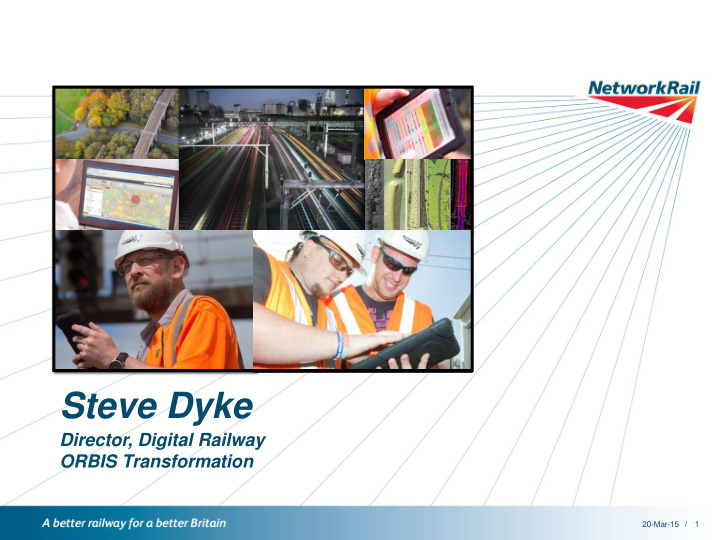



Steve Dyke Director, Digital Railway ORBIS Transformation 20-Mar-15 1 /
Network Rail Introduction Video 20-Mar-15 /
The Scale of the Challenge 20-Mar-15 /
The Scale of the Infrastructure 20,000 757 7,400 Miles of Signal Commercial track Boxes Properties 32,000 Bridges and Tunnels 23,000 19 6,100 Level Switches Managed Crossings & Stations Crossings 20-Mar-15 /
Data to Intelligence – How we Deliver National Intelligence ORBIS Delivery Disciplines Model (NIM) Data Technology Services Business Change & Benefits Collect Present a change programme to the business Manage the build complexity behind the scene Providing Asset Maintenance (Building) Effectiveness ORBIS Programme Workstreams Tools for Capture, Enabling Evaluate Maintain & Access Quality Asset Data Operational Performance People & business to realise the benefits Effectiveness Collate Ability to join and view asset data Move to an information Renewals & enabled mobile work Supply chain force Effectiveness Process Decision Support Tools Strategic Planning Comm Effectiveness 20-Mar-15 5 / 5
Delivering the Vision DELIVERING THE VISION /
What is RINM? Rail Infrastructure Network Model (RINM) is providing a network model of the railway. It consists of two models: •A location (“Geospatial”) model accurately plotting the place of assets and their information in the real world •A relationship (“Logical”) model providing an understanding of how changes to assets will impact on others (for example, how changing the track would impact on the signalling, and how that would impact on the electrification of the line itself) RINM can be viewed either on map or on a schematic RINM will be used by up to 36,000 Network Rail staff – covering almost the entirety of the organisation – and up to 3,500 external users, including the Emergency Services and British Transport Police. Railway Model ... High Accuracy / 7
What more do we get from RINM? Oblique Imagery Viewed on a Map Aerial Survey Imagery Feature Extraction Schematic Near Real Time /
RINM is going to help us work differently in the future… Once ALL of these products have been made available, there are numerous benefits that we will realise: Improved trackside worker safety as more activities can be conducted from desktop. Further, those who still need to access site, can do so equipped with more detailed information Supported preventative maintenance through identification of high risks sites which can reduce incidents and therefore delay minutes Quicker incident response through more accessible visualisation of local points of interest, for example access points Reduced trespass & vandalism through enhanced information to identify and analyse access points Improved planning quality and efficiency as more information readily available about potential work sites Reduced survey costs though using the Aerial Survey data in the Geo-RINM Viewer /
Powered by Network Mapping capture Aerial Survey of the Rail Network The survey data is prepared by Network Mapping for load Airbus check the quality of the images Amazon Web Services are used for the storage 245 Tb of data The CSC Big Data Platform as a Service is used The data is automatically ingested and indexed The service is inexpensive and data retrieval is fast Data is provided for the users to view via an external viewer. This includes LiDAR Point Cloud, Digital Terrain Model, Surface Model, Tree Database, Infrared & Oblique Imagery. Currently 60 Network Rail users have access to the data This will become 4500 users in phase 2 It will also include access to 3 rd Parties Access to a higher volume of data could be included : Measurement Trains, FFCCTV, 3D, Condition Data, Predictive Maintenance ... /
Recommend
More recommend